
| Horse Hippology | ||

|
||
In general, there is no physiological benefit to the horse having a "pretty" head. Ugly-headed horses are able to breathe, see, hear and ingest food. Basically, an ugly head functions similarly to a beautiful head. However, most people do not want to own an ugly-headed horse, so selection is based upon beauty.
What makes a head pretty or attractive? Certainly the set of the ears, shape of the eye, size of the nostril, depth of the mouth and overall proportionality of the head is important to our concept of beauty. Basically the ears will be proportional to the horse's head. In fact, as the reader progresses, it will become apparent that the various parts of the horse are always proportional. However, the placement of the ears will not always be the same. It is important that the ears sit squarely on top of the head, that they point forward and have an attractive, alert appearance. Some horse's ears turn outward, some turn inward, and some are positioned on the side of the head and are referred to as loop-eared. Any deviation in placement or carriage detracts from the beauty of the head, thus from the total beauty of the horse.

|
Most judges give preference to horses with a long, thin neck, when in reality they should be selecting horses with the appropriate top to bottom line neck ratio. The top line is the distance from the poll to the withers and the bottom line is the distance from the throatlatch to the neck-shoulder junction at the chest. The ideal would be approximately a 2 to 1 ratio of the top to bottom line of the horse's neck. This process of selection would prevent judges from making incorrect assumptions when comparing tall and light-muscled horses to short and heavier-muscled horses. Invariably, a horse that is short and oval-muscled will have a shorter, thicker neck than a taller horse with less muscle. The neck is typically proportional to the horse's overall length and height. Certainly, shorter horses will always have shorter necks than taller horses.
The determining factor in the ratio of the top to bottom line of the neck is the slope of the horse's shoulder. As the shoulder becomes more sloping, the top line becomes longer in relation to the bottom line. Conversely, as the shoulder becomes straighter, the ratio of the top to bottom line becomes small. As the ratio deviates toward 1:1, the horse appears to have a short, square, boxy neck. When two horses of the same frame size are compared, one with a normal neck and one with a short-appearing neck, both horses will have the same length in the bottom line of their necks. Obviously, the withers of a straighter-shouldered horse are more forward and thus, the top line of the neck is shortened. A straighter shoulder has little, if any, effect on the length of the bottom line of the neck.

|
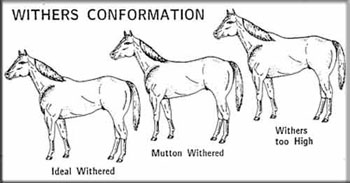
|
The ideal withers should be sharp, prominent and well-defined. Well-defined withers are important because they hold a saddle on the horse without the need to excessively tighten the front cinch. Horses with rounded or flat withers require more cinch pressure to secure the saddle which means subsequently less comfort for the performing athlete.
Horses should have short, strong backs relative to a long underline. The topline to underline ratio plays an important role in balance, length and type of stride. Length of back is directly related to length and slope of shoulder as well as to the top to bottomline neck ratio. Horses that have excessively long backs are unbalanced and weaker in their toplines than shorter-backed horse.
The loin(coupling) is the pivot point of the horse's back and is the area between the last rib and the croup. It should be well-muscled and strong as opposed to being long, weak and poorly muscled. Short, muscular loins are needed to carry power from the hind legs forward.
The croup should be long and gentlysloping. This adds length to the stride as well as dimension and muscling to the hindquarter. "Stock horse" breeds (Quarter Horses) are more sloping in their croup than "pleasure breeds" (Arabians, Morgans).
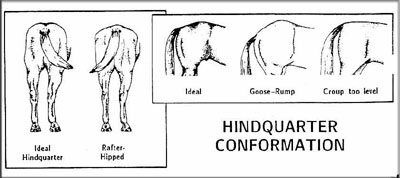
|
The ideal horse has a hindquarter that is full and as long from across the horizontal plane of the stifle as it is from point of hip to point of buttocks. When a horse has a V-shaped quarter, it is due to limited muscling and/or a straight stifle.
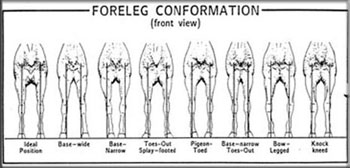
|
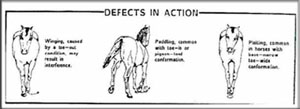
|
It is important to have proper bone length and angle to achieve proper horse conformation. Further, as viewed from the front, a straight line from the point of the shoulder ahould bisect the entire front leg all the way to the toe. There should be two equal parts in the ideally structured horse. Although this is actually rare, the toes and knees should point straight forward. Additionally, the width of the toes on the ground should be the same width as their origin in the chest. The cannon bone should be centered on the knee and fetlock.
There are several deviations to the ideal front column of bones as viewed from the front. Such deviations have the potential to affect movement and, subsequently, performance. Horses whose toes point inward (toed-in) are referred to as "pigeon-toed," while horses that have toes that point outward (toes-out) are called "splay-footed."
An additional structural deviation in the front leg is base-narrow. This condition is indicative of a horse that stands closer at the ground than at the origin of the legs in the chest. This is typical of horses with large muscle mass. The base-narrow horse is prediposed to landing on the outside of its hoof walls. Due to the extra weight placed on the outside of the hoof, horses develop conditions such as ringbone, sidebone and heel brusing. Horses with this conformational problem can either toe-in or toe-out.
Base-wide conformation positions the horse's feet wider at the ground than at their origin at the chest. This condition is seen in many narrow-chested horses and is usually accomplanied by feet that toe-out. Unlike the base-narrow horse, this condition allows for more weight to be distributed to the inside of the horse's hoof. Horses that are base-wide are also predisposed to ring-bone and sidebone.
Bowlegs, knock-knees and bench knees are other exaqmples of poor conformation that may affect soundness. Bowlegged horses present the entire knee in an outward deviation as viewed from the front. This condition causes increased tension on the outside of the leg due to unequal distribution of concussion and force. Knock-kneed of close-kneed horses have the entire knee set to the inside of a straight line from chest to toe. This condition is generally accompanied by toe-out feet and with some degree of outward rotation of the cannon and fetlock. Again, this condition predisposes the horse to unsoundness due to an unequal line of concussion.
Bench knees is another structural fault in horses. Bench or offset knees are characteristic of a horse with cannon bones set too far to the outside of the knee. This conformational problem increases the possibility for horses to develop splints.
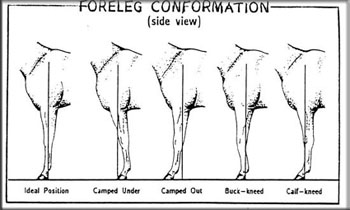
|
Some horses may be camped in front (camped under). This condition refersto a horse whose forelimb is too far under its body. This camped-in effect will prevent a horse from having a long, fluid stride and predisposes the animal to unsoundness. These horses typically exert excessive wear on the hoofwith an increase in pressure on ligaments and tendons.
Camped-out refers to horses whose entire forelimb is too far forward and away from the body. These horses will exert excessive concussion and stress on their knees, ankles, and hoofs. These horses are predisposed to navicular disease and laminitis.
Two primary structural deviations exist in the knees of horses as they are viewed from the side. The most frequently condition is "over at the knees," commonly referred to as buck-kneed. This is a forward eviration, withthe knee set too far forwardin relation to the leg. Although buck knees are a structural deviation, such horses are typically capable of a long performance life.
The opposite condition to buck-knees is "back at the knees"or "calf-kneed" legs. This conformation fault is extremely seriousand many calf-kneed horses do not stay sound. This condition positions the horse's knees back behind the vertical inits leg. Calf-knees allow the knees to bend backwards (hyperextend) and predispose the horse to unsoundness.
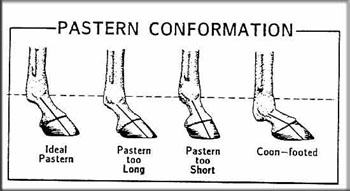
|
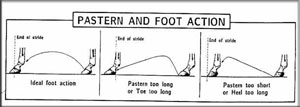
|
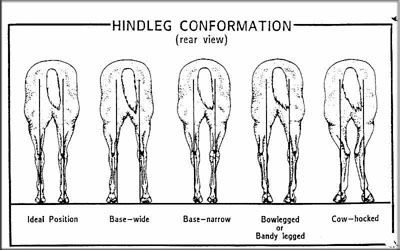
|
Horses that are bowed-in at the hocks and cannon bones insteadof being parallel are referred to as cow-hocked. Typically, their hocks are set too close together pointing toward one another with their feet widely seperated. These horses have hind limbs that are base-narrow from the buttocks to the hocks and base-wide from the hocks to the toes. The horse that is cow-hocked tends to be weak in the major movements that require work off of the haunches, such as stopping, turning and sliding.
Occasionally there are horses that actually toe-in behind and are "out at the hock." Bow-legged horses have hocks that are too far apart and are generally predisposed to being base-narrow. These horses have added strain on their bones, ligaments and joints and may have many types of interference in movement. These horses are typically very poor athletes and should be severly faulted.
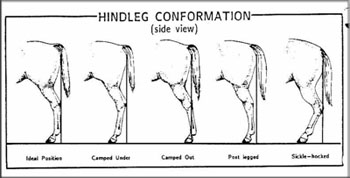
|